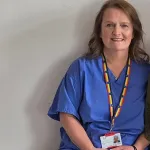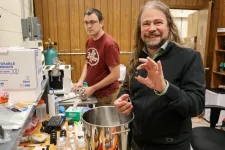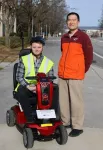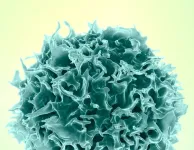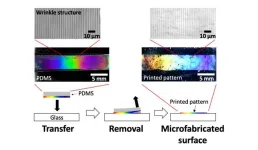(Press-News.org) CAMBRDIGE, MA – Wearable devices like smartwatches and fitness trackers interact with parts of our bodies to measure and learn from internal processes, such as our heart rate or sleep stages.
Now, MIT researchers have developed wearable devices that may be able to perform similar functions for individual cells inside the body.
These battery-free, subcellular-sized devices, made of a soft polymer, are designed to gently wrap around different parts of neurons, such as axons and dendrites, without damaging the cells, upon wireless actuation with light. By snugly wrapping neuronal processes, they could be used to measure or modulate a neuron’s electrical and metabolic activity at a subcellular level.
Because these devices are wireless and free-floating, the researchers envision that thousands of tiny devices could someday be injected and then actuated noninvasively using light. Researchers would precisely control how the wearables gently wrap around cells, by manipulating the dose of light shined from outside the body, which would penetrate the tissue and actuate the devices.
By enfolding axons that transmit electrical impulses between neurons and to other parts of the body, these wearables could help restore some neuronal degradation that occurs in diseases like multiple sclerosis. In the long run, the devices could be integrated with other materials to create tiny circuits that could measure and modulate individual cells.
“The concept and platform technology we introduce here is like a founding stone that brings about immense possibilities for future research,” says Deblina Sarkar, the AT&T Career Development Assistant Professor in the MIT Media Lab and Center for Neurobiological Engineering, head of the Nano-Cybernetic Biotrek Lab, and the senior author of a paper on this technique.
Sarkar is joined on the paper by lead author Marta J. I. Airaghi Leccardi, a former MIT postdoc who is now a Novartis Innovation Fellow; Benoît X. E. Desbiolles, an MIT postdoc; Anna Y. Haddad ’23, who was an MIT undergraduate researcher during the work; and MIT graduate students Baju C. Joy and Chen Song. The research appears today in Nature Communications Chemistry.
Snugly wrapping cells
Brain cells have complex shapes, which makes it exceedingly difficult to create a bioelectronic implant that can tightly conform to neurons or neuronal processes. For instance, axons are slender, tail-like structures that attach to the cell body of neurons, and their length and curvature vary widely.
At the same time, axons and other cellular components are fragile, so any device that interfaces with them must be soft enough to make good contact without harming them.
To overcome these challenges, the MIT researchers developed thin-film devices from a soft polymer called azobenzene, that don’t damage cells they enfold.
Due to a material transformation, thin sheets of azobenzene will roll when exposed to light, enabling them to wrap around cells. Researchers can precisely control the direction and diameter of the rolling by varying the intensity and polarization of the light, as well as the shape of the devices.
The thin films can form tiny microtubes with diameters that are less than a micrometer. This enables them to gently, but snugly, wrap around highly curved axons and dendrites.
“It is possible to very finely control the diameter of the rolling. You can stop if when you reach a particular dimension you want by tuning the light energy accordingly,” Sarkar explains.
The researchers experimented with several fabrication techniques to find a process that was scalable and wouldn’t require the use of a semiconductor clean room.
Making microscopic wearables
They begin by depositing a drop of azobenzene onto a sacrificial layer composed of a water-soluble material. Then the researchers press a stamp onto the drop of polymer to mold thousands of tiny devices on top of the sacrificial layer. The stamping technique enables them to create complex structures, from rectangles to flower shapes.
A baking step ensures all solvents are evaporated and then they use etching to scrape away any material that remains between individual devices. Finally, they dissolve the sacrificial layer in water, leaving thousands of microscopic devices freely floating in the liquid.
Once they have a solution with free-floating devices, they wirelessly actuated the devices with light to induce the devices to roll. They found that free-floating structures can maintain their shapes for days after illumination stops.
The researchers conducted a series of experiments to ensure the entire method is biocompatible.
After perfecting the use of light to control rolling, they tested the devices on rat neurons and found they could tightly wrap around even highly curved axons and dendrites without causing damage.
“To have intimate interfaces with these cells, the devices must be soft and able to conform to these complex structures. That is the challenge we solved in this work. We were the first to show that azobenzene could even wrap around living cells,” she says.
Among the biggest challenges they faced was developing a scalable fabrication process that could be performed outside a clean room. They also iterated on the ideal thickness for the devices, since making them too thick causes cracking when they roll.
Because azobenzene is an insulator, one direct application is using the devices as synthetic myelin for axons that have been damaged. Myelin is an insulating layer that wraps axons and allows electrical impulses to travel efficiently between neurons.
In non-myelinating diseases like multiple sclerosis, neurons lose some insulating myelin sheets. There is no biological way of regenerating them. By acting as synthetic myelin, the wearables might help restore neuronal function in MS patients.
The researchers also demonstrated how the devices can be combined with optoelectrical materials that can stimulate cells. Moreover, atomically thin materials can be patterned on top of the devices, which can still roll to form microtubes without breaking. This opens up opportunities for integrating sensors and circuits in the devices.
In addition, because they make such a tight connection with cells, one could use very little energy to stimulate subcellular regions. This could enable a researcher or clinician to modulate electrical activity of neurons for treating brain diseases.
“It is exciting to demonstrate this symbiosis of an artificial device with a cell at an unprecedented resolution. We have shown that this technology is possible,” Sarkar says.
In addition to exploring these applications, the researchers want to try functionalizing the device surfaces with molecules that would enable them to target specific cell types or subcellular regions.
###
The research was supported by the Swiss National Science Foundation and the U.S. National Institutes of Health Brain Initiative.
END
“Wearable” devices for cells
By snugly wrapping around neurons, these devices could help scientists probe subcellular regions of the brain, and might even help restore some brain function
2024-10-31
ELSE PRESS RELEASES FROM THIS DATE:
Cancer management: Stent sensor can warn of blockages in the bile duct
2024-10-31
Images
Stents to treat various blockages in the human body can themselves become blocked, but a new sensor developed at the University of Michigan for stents that are used in the bile duct may one day help doctors detect and treat stent blockages early, helping keep patients healthier.
Bile duct blockages can cause jaundice, liver damage and potentially life-threatening infections. Conditions that cause the bile ducts to narrow and close, including pancreatic and liver ...
Nov. 14 AARP Author Q&A at GSA 2024 in Seattle: Debra Whitman, Global Aging Expert and Author of ‘The Second Fifty: Answers to the 7 Big Questions of Midlife and Beyond’
2024-10-31
Author Q&A: Debra Whitman, Global Aging Expert and Author of “The Second Fifty”
Date: Thursday, November 14
Time: 4:30 to 5:30 p.m. PT
Location: Seattle Convention Center Arch Building Room 305
Registration: GSA 2024 Annual Scientific Meeting media registration is required to attend this event.
During this meet-the-author media roundtable, Debra Whitman, executive vice president and chief public policy officer at AARP, will discuss her new book, “The Second Fifty: Answers to the 7 Big ...
Autistic psychiatrists who don't know they're autistic may fail to spot autism in patients
2024-10-31
Groundbreaking research exploring the experiences of autistic psychiatrists has revealed that psychiatrists who are unaware that they themselves are autistic may fail to recognise the condition in their patients. The study, conducted by researchers from University College Dublin, London South Bank University, Brighton and Sussex Medical School, is the first of its kind to delve into the lives of neurodivergent psychiatrists. It was published today in BJPsych Open.
"Knowing that you are autistic can be positively life-changing," said the study author Dr Mary Doherty, Clinical Associate ...
New findings on animal viruses with potential to infect humans
2024-10-31
COLUMBUS, Ohio – Scientists investigating animal viruses with potential to infect humans have identified a critical protein that could enable spillover of a family of organisms called arteriviruses.
In a new study, researchers identified a protein in mammals that welcomes arteriviruses into host cells to start an infection. The team also found that an existing monoclonal antibody that binds to this protein protects cells from viral infection.
Arteriviruses circulate broadly in many types of mammals around the world that serve as natural hosts – such as ...
Ancient rocks may bring dark matter to light
2024-10-31
The visible universe — all the potatoes, gas giants, steamy romance novels, black holes, questionable tattoos, and overwritten sentences — accounts for only 5 percent of the cosmos.
A Virginia Tech-led team is hunting for the rest of it, not with telescopes or particle colliders, but by scrutinizing billion-year-old rocks for traces of dark matter.
In leading a transdisciplinary team from multiple universities on this unconventional search, physics’ Patrick Huber is also taking an unconventional step: from theoretical work into experimental work.
With support from a $3.5 million Growing Convergence Research ...
Study reveals acceleration in Pacific upper-ocean circulation over past 30 years, impacting global weather patterns
2024-10-31
A new study published October 31, 2024, in the Journal of Geophysical Research: Oceans has revealed significant acceleration in the upper-ocean circulation of the equatorial Pacific over the past 30 years. This acceleration is primarily driven by intensified atmospheric winds, leading to increased oceanic currents that are both stronger and shallower, with potential impacts on regional and global climate patterns, including the frequency and intensity of El Niño and La Niña events. The study provides a spatial view of these long-term trends from observations, adding at least ...
Virginia Tech researcher finds AI could help improve city planning
2024-10-31
Traditional city planning methods require significant technical expertise and manual work.
A Virginia Tech researcher is working to change that.
New research shows the potential of large language models (LLMs), such as ChatGPT and Google’s Gemini, for assessing the human-made environment using street-view images.
By comparing LLM performance with traditional city planning deep learning methods, the study from the College of Natural Resources and Environment found that LLM-based performance is similar with established approaches. Unlike ...
A trick of light: UC Irvine researchers turn silicon into direct bandgap semiconductor
2024-10-31
Irvine, Calif., Oct. 31, 2024 — By creating a new way for light and matter to interact, researchers at the University of California, Irvine have enabled the manufacturing of ultrathin silicon solar cells that could help spread the energy-converting technology to a vast range of applications, including thermoelectric clothing and onboard vehicle and device charging.
The development, subject of a paper recently published as the cover story in the journal ACS Nano, hinges on the UC Irvine researchers’ conversion of pure silicon from an indirect to a direct bandgap semiconductor through the way it interacts ...
NIH trial of rectal microbicide for HIV prevention begins in the United States
2024-10-31
WHAT:
A clinical trial sponsored by the National Institutes of Health (NIH) has launched to examine the safety and acceptability of a novel rectal HIV microbicide douche containing the antiretroviral drug tenofovir. This “on-demand” HIV prevention approach involves using the microbicide prior to a potential exposure from receptive anal intercourse.
Several forms of HIV pre-exposure prophylaxis (PrEP) are in use in the United States and globally, namely daily oral pills, long-acting injections, and a monthly vaginal ring. The Centers for Disease Control and Prevention advises that gay, bisexual and other men who have sex with ...
Development of a simple, revolutionary printing technique for periodic nano/microstructures
2024-10-31
1. A team of researchers from NIMS and the University of Connecticut has developed a printing technique capable of forming a periodic nano/microstructure on the surface of a polydimethylsiloxane (PDMS) slab and easily transferring it onto the surface of a glass substrate. This technique enables us to create materials with useful functions—including water-repellency and the ability to generate structural colors—without expensive equipment and complex processes. In addition, the technique may be used to fabricate materials capable of realizing anti-fogging and/or generating structural colors on their surfaces—functions potentially useful in the development ...
LAST 30 PRESS RELEASES:
Ticking time bomb: Some farmers report as many as 70 tick encounters over a 6-month period
Turning garden and crop waste into plastics
Scientists discover ‘platypus galaxies’ in the early universe
Seeing thyroid cancer in a new light: when AI meets label-free imaging in the operating room
Neutrophil-to-lymphocyte ratio may aid risk stratification in depressive disorder
2026 Seismological Society of America Annual Meeting
AI-powered ECG analysis offers promising path for early detection of chronic obstructive pulmonary disease, says Mount Sinai researchers
GIMM uncovers flaws in lab-grown heart cells and paves the way for improved treatments
Cracking the evolutionary code of sleep
Medications could help the aging brain cope with surgery, memory impairment
Back pain linked to worse sleep years later in men over 65, according to study
CDC urges ‘shared decision-making’ on some childhood vaccines; many unclear about what that means
New research finds that an ‘equal treatment’ approach to economic opportunity advertising can backfire
Researchers create shape-shifting, self-navigating microparticles
Science army mobilizes to map US soil microbiome
Researchers develop new tools to turn grain crops into biosensors
Do supervised consumption sites bring increased crime? Study suggests that’s a myth
New mass spec innovation could transform research
Maternal nativity, race, and ethnicity and infant mortality in the US
Migration-related trauma among asylum seekers exposed to the migrant protection protocols
Jupiter’s moon Europa has a seafloor that may be quiet and lifeless
SwRI upgrades nuclear magnetic resonance laboratory for pharmaceutical R&D
House sparrows in northern Norway can help us save other endangered animals
Crohn's & Colitis Foundation survey reveals more than 1/3 of young adults with IBD face step therapy insurance barriers
Tethered UAV autonomous knotting on environmental structures for transport
Decentralized social media platforms unlock authentic consumer feedback
American Pediatric Society announces Vanderbilt University School of Medicine as host institution for APS Howland Visiting Professor Program
Scientists discover first method to safely back up quantum information
A role for orange pigments in birds and human redheads
Pathways to net-zero greenhouse gas emissions for Southeast Asia
[Press-News.org] “Wearable” devices for cellsBy snugly wrapping around neurons, these devices could help scientists probe subcellular regions of the brain, and might even help restore some brain function

